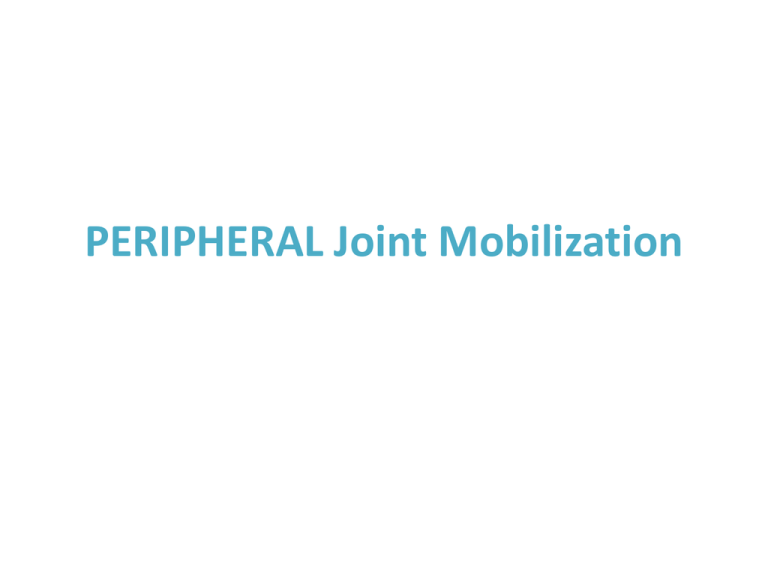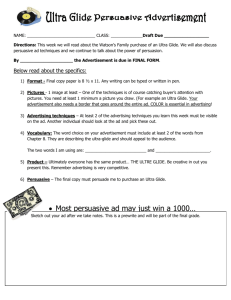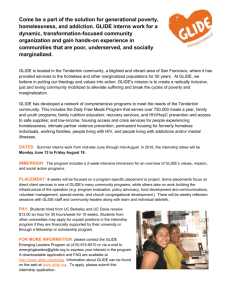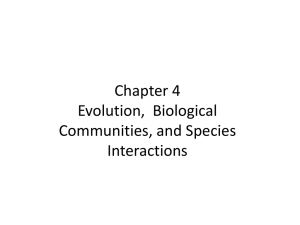PERIPHERAL Joint Mobilization
advertisement

PERIPHERAL Joint Mobilization PERIPHERAL JOINT MOBILIZATION TECHNIQUES Shoulder Girdle Complex Glenohumeral Joint • The concave glenoid fossa receives the convex humeral head Resting Position • The shoulder is abducted 55, horizontally adducted 30, and rotated so the forearm is in the horizontal plane Shoulder Girdle Complex Treatment Plane • The treatment plane is in the glenoid fossa and moves with the scapula Stabilization • Fixate the scapula with a belt or have an assistant help. Shoulder Girdle Complex • Glenohumeral Distraction Indications • Testing • Initial Treatment (sustained grade II) • Pain control (grade I or II oscillations) • General mobility (sustained grade III). Shoulder Girdle Complex • Glenohumeral Caudal Glide, Resting Position Indications • To increase abduction (sustained grade III); to reposition the humeral head if superiorly positioned CAUDAL GLIDE Glenohumeral joint: caudal glide in the resting position. Note that the distraction force is applied by the hand in the axilla, and the caudal glide force is from the hand superior to the humeral head. Glenohumeral Elevation Progression INDICATION • To increase elevation beyond 90 of abduction Glenohumeral joint: elevation progression in the sitting position. This is used when the range is greater than 90. Note the externally rotated position of the humerus; pressure against the head of the humerus is toward the axilla Glenohumeral Posterior Glide, • Resting Position Indications • To increase flexion; to increase internal rotation Glenohumeral joint: posterior glide in the resting position Glenohumeral Posterior Glide Progression • Indications • To increase posterior gliding when flexion approaches 90; to increase horizontal adduction Glenohumeral joint: posterior glide progression. One hand (A) or a belt Glenohumeral Posterior Glide Progression • Indications • To increase posterior gliding when flexion approaches 90; to increase horizontal adduction. Glenohumeral joint: posterior glide progression is used to exert a grade 1 distraction force Glenohumeral Anterior Glide, Resting Position Indications • To increase extension; to increase external rotation Glenohumeral joint: anterior glide in the resting position Glenohumeral External Rotation Progressions Indication • To increase external rotation Glenohumeral joint: distraction for external rotation progression. Note that the humerus is positioned in the resting position with maximum external rotation prior to the application of distraction Acromioclavicular Joint: Anterior Glide • Indication • To increase mobility of the joint. Acromioclavicular joint: anterior glide Sternoclavicular Joint • The proximal articulating surface of the clavicle is convex superiorly/inferiorly and concave anteriorly/posteriorly Patient Position and Stabilization • Supine; the thorax provides stability to the sternum. Sternoclavicular Posterior Glide and Superior Glide Indications • Posterior glide to increase retraction • superior glide to increase depression of the clavicle Sternoclavicular joint: posterior and superior glides. (A) Press down with the thumb for posterior glide. (B) Press upward with the index finger for superior glide Sternoclavicular Anterior Glide and Caudal (Inferior) Glide Indications • Anterior glide to increase protraction • caudal glide to increase elevation of the clavicle. Sternoclavicular joint: anterior and inferior glides. (A) Pull the clavicle upward for an anterior glide. (B) Press caudalward with the curled fingers for an inferior glide Scapulothoracic Mobilization • The scapulothoracic articulation is not a true joint, but the soft tissue is stretched to obtain normal shoulder girdle Mobility Indications • To increase scapular motions of elevation, depression, protraction, retraction, rotation, Scapulothoracic articulation: elevation, upward and downward depression, protraction, retraction, upward and downward rotations, and winging rotations, and winging Elbow and Forearm Complex • The elbow and forearm complex consists of four joints: – – – – Humeroulnar Humeroradial Proximal radioulnar Distal radioulnar • For full elbow flexion and extension, accessory motions of varus and valgus (with radial and ulnar glides) are necessary. . Bones and joints of the elbow complex Humeroulnar Articulation • The convex trochlea articulates with the concave olecranon fossa. Resting Position • Elbow is flexed 70, and forearm is supinated 10 Bones and joints of the elbow complex Humeroulnar Articulation Treatment Plane • The treatment plane is in the olecranon fossa, angled approximately 45 from the long axis of the ulna Stabilization • Fixate the humerus against the treatment table with a belt or use an assistant to hold it. • The patient may roll onto his or her side and fixate the humerus with the contralateral hand if muscle relaxation can be maintained around the elbow joint being mobilized. Humeroulnar Distraction and Progression Indications • Testing • Initial Treatment (sustained grade II) • Pain control (grade I or II oscillation) • To increase flexion or extension (grade III or IV). Humeroulnar joint: Distraction Humeroulnar Distal Glide Indication • To increase flexion. distraction with distal glide (scoop motion). Humeroulnar Radial Glide Indication • To increase varus. – An accessory motion of the joint that accompanies elbow flexion • used to progress flexion • Mobilizing Force against the ulna in a radial direction. Humeroulnar Ulnar Glide • Indication • To increase valgus. – an accessory motion of the joint that accompanies elbow extension • used to progress extension • Mobilizing Force applied against the distal humerus in a radial direction, causing the ulna to glide ulnarly. Humeroradial Articulation • The convex capitulum articulates with the concave radial head Resting Position • Elbow is extended, and forearm is supinated to the end of the available range. Treatment Plane • The treatment plane is in the concave radial head perpendicular to the long axis of the radius. Stabilization • Fixate the humerus with one of your hands. Bones and joints of the elbow complex Humeroradial Distraction Indications • To increase mobility of the humeroradial joint; to manipulate a pushed elbow (proximal displacement of the radius Humeroradial joint: distraction Humeroradial Dorsal/Volar Glides • Indications • Dorsal glide head of the radius to increase elbow extension; • volar glide to increase flexion. Humeroradial joint: dorsal and volar glides. This may also be done sitting, as in Figure 5.32, with the elbow positioned in extension and the humerus stabilized by the proximal hand (rather than the ulna). Humeroradial Dorsal/Volar Glides (in sitting) Humeroradial joint: dorsal and volar glides Humeroradial Compression Indication • To reduce a pulled elbow subluxation Humeroradial joint: compression manipulation. This is a quick thrust with simultaneous supination and compression of the radius Proximal Radioulnar Joint, Dorsal/Volar Glides • The convex rim of the radial head articulates with the concave radial notch on the ulna Resting Position • The elbow is flexed 70 and the forearm supinated 35. Treatment Plane • The treatment plane is in the radial notch of the ulna, parallel to the long axis of the ulna. Stabilization • Proximal ulna is stabilized Bones and joints of the elbow complex Proximal Radioulnar Joint, Dorsal/Volar Glides • Indications • Dorsal glide to increase pronation; volar glide to increase supination Proximal radioulnar joint: dorsal and volar glides. Distal Radioulnar Joint, Dorsal/Volar Glides • The concave ulnar notch of the radius articulates with the convex head of the ulna. Resting Position • The resting position is with the forearm supinated 10. Treatment Plane The treatment plane is the articulating surface of the radius, parallel to the long axis of the radius. Stabilization • Distal ulna. Bones and joints of the elbow complex Distal Radioulnar Joint, Dorsal/Volar Glides • Indications • Dorsal glide to increase supination; volar glide to increase pronation Distal radioulnar joint: dorsal and volar glides




